The Modern Way: Rosso, Soffici, Boccioni
Maria Elena Versari Maria Elena Versari Medardo Rosso, Issue 6, December 2021https://italianmodernart.org/journal/issues/medardo-rosso/
While scholars have reassessed Medardo Rosso’s position within the canon of modern sculpture, and experts are aware of the role played by Ardengo Soffici in his early reception, understandings of Rosso’s impact on Italian modernism and Futurist aesthetics are still sketchy. This essay aims to clarify the importance that Rosso’s work had on the development of Umberto Boccioni’s theories of art and on his sculptural production, and the problematic role that Soffici’s own understanding of Rosso played in the definition of Futurist aesthetics. In particular, the author analyzes Rosso’s, Soffici’s and Boccioni’s divergent codifications of central conceptual terms, such as atmosphere. Furthermore, the author examines in detail a number of sculptures (Rosso’s The End and The Church Janitor, Boccioni’s Fusion of a Head and a Window, Antigrazioso, and Head+House+Light) to illustrate the distance between Rosso’s and Boccioni’s approaches to vision, spatial representation, and the incorporation of reality in sculpture.
When news of a new Futurist manifesto devoted to sculpture reached Paris at the end of September 1912, Medardo Rosso did not seem to appreciate it that much. “All of Rosso’s theories are pillaged,” commented in his diary Rosso’s friend Jean Rictus. A couple of days later, the two planned to respond publicly with an article penned by Rictus.1 On June 7, Filippo Tommaso Marinetti and Umberto Boccioni had visited Rosso in his Parisian atelier. Boccioni was working on the idea of a manifesto that would revolutionize the “mummified” (his words) art of sculpture. Rictus felt that Marinetti (and Boccioni) had had some nerve stealing most of Rosso’s ideas and turning them into a carnival.2 He wrote as much in the article he published in Comoedia in January 1913, calling Boccioni’s manifesto nothing more than “a caricatural forgery of Rosso’s efforts and formulas (une contrefaction caricaturale des efforts et des formules de Rosso).”3
While recent scholarship has reassessed Medardo Rosso’s position within the canon of modern sculpture, and experts are increasingly aware of the influence he had on Boccioni’s definition of Futurist sculpture, the way in which Rosso’s ideas and works were appropriated by Boccioni still requires further investigation. In this essay, I would like to call attention to two issues that have been largely overlooked until now: first, the interplay among Rosso’s statements on sculpture, Ardengo Soffici’s writings on Rosso, and Umberto Boccioni’s theories; second, the substantial differences between Rosso and Boccioni’s early approaches to vision, spatial representation, and the incorporation of reality in their works.
According to Zeno Birolli, Rosso’s work “left an indelible mark” on Futurism.4 This is specifically due, in my opinion, to the way in which it was mediated through Soffici’s criticism. It was Soffici who, at the beginning of century, did the most to reconfigure Rosso’s reputation in Italy. He saw the task of revealing the sculptor’s merits as indissolubly bound to a national program of modernization. His position can be summarized as follows: Rosso was an Italian artist who had moved to Paris and while there had revolutionized the art of sculpture. He had joined two seemingly distant concepts: sculpture, and what Soffici himself considered the root of modernity in art, Impressionism. As was the case with many of its most innovative artists, however, Italy had failed Rosso. He was still waiting to be recognized in his own country – at the Venice Biennale or elsewhere. These are, in sum, the arguments that Soffici put forth repeatedly to the Italian public. To promote Rosso, he first staged a major journalistic campaign with a series of articles in the leading periodical La Voce, which he then collected and published as a book, significantly titled Il caso Rosso (The case of Rosso) (Figure 1).
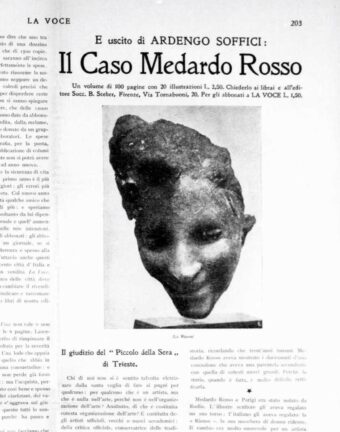
Finally, he organized an exhibition in Florence, which brought together several French Impressionist paintings and Rosso’s sculptures. For Soffici, Italy’s late recognition of Rosso went hand in hand with the country’s belated embrace of modernity. Writing in La Voce in 1909, he stated: “For an artist such as Rosso to be understood, loved, and esteemed for his true worth, in a country like Italy, enlightened critics would have had to investigate and establish in advance and for many years what are the radical differences between the ancient and modern way of conceiving life and beauty.”5
It was indeed the search for this “modern way” that characterized the Futurists’ work from the very beginning and that led them to refer to Rosso repeatedly in their writings, well before Boccioni’s 1912 Manifesto of Futurist Sculpture. Rosso became the underlying fil rouge that tied Soffici and the Futurists in a communal battle, even if their aesthetic criteria, at least at first, did not match at all. In 1910, the Futurists sent him a telegram: “In spite of the hostility towards Futurism of your friends from La Voce, we, knowing of your brave campaign for the great Medardo Rosso, […] feel the need to express to you our brotherly admiration.”6
While Rosso and Rictus might have felt that Boccioni had pillaged the ideas that the sculptor had expressed in his studio during the Futurists’ June 1912 visit, the Technical Manifesto of Futurist Sculpture relied more overtly on what Soffici had already stated about Rosso’s thought. In 1909, Soffici had written that, for Rosso, “it is not true that sculpture is doomed to produce only forms of beauty that are isolated in space, enclosed within stark, still, and definite lines; forms that are almost confined within a profile of immobility, detached from the spinning center of universal life, that remain there, frozen, letting the nosy visitors of an exhibition or a gallery observe them from all sides.”7 We find, in Soffici’s prose, many of the ideas and even the jargon that Boccioni later used in his manifesto and other writings. Some were direct quotations from Rosso, but others stretched the sculptor’s concepts beyond his actual statements. The term “isolated in space” (“isolato nello spazio”), employed by Soffici in his 1909 essay on Rosso, for example, is an expression that Boccioni uses in his preface to the catalogue of the First Exhibition of Futurist Sculpture in 1913 and, repeatedly, in his 1914 book, Futurist Painting Sculpture. Rosso himself had defined the concept in the text that he had written to Edmond Claris for his book Impressionism in sculpture, by saying: “It is impossible to see a horse with four legs in one single instant, or a man, isolated in space like a doll. Similarly, I feel that this horse and this man belong to a whole from which they cannot be detached, they belong to an environment, and the artist must take this into consideration.”8 He had however immediately clarified that this was for him a question of visual perception: “You cannot perceive two effects at the same time […] You do not turn around a statue just like you do not turn around a painting, because you don’t turn around a form to conceive its impression.”9 Rosso then concluded with what is probably his most famous statement: “Nothing is material in space. Thus conceived, art is indivisible. We do not have painting on one side and sculpture on the other.” Rosso was clearly referring to the conflict between perception and abstraction, in time (it is impossible for the human eye to distinguish the four legs of a horse in motion, for example),10 or in space (it is impossible for the human eye to detach a human figure from its background). For him, the idea that “nothing is material in space” meant that space is a perceptual dimension, and art is first and foremost something that we perceive as a visual impression – its material condition does not matter. This implied, as Claris quickly recognized, that Rosso was trying to establish a form of sculpture to be seen from “un point de vue unique,” a single point of view, something that Charles Baudelaire had famously dismissed as impossible for sculpture. “The spectator who turns around a figure can choose one hundred different points of view,” remarked Baudelaire, “except the right one. And often (and this is humiliating for the artist) a fortuitous ray of light, the effect of a lamp, reveal a form of beauty that is not the one that he had envisioned.”11
Soffici, however, translated the sculptor’s visual concerns and his statement on the momentary nature of an impression into a vitalistic definition of reality in line with the philosophy of Henri Bergson. According to Soffici, Rosso’s concerns seem to go beyond the idea of a unifying visual plane of momentary perception to invest the vibrating and living nature of its content, matter: “Just like painting, sculpture, too, can vibrate in a thousand fractured lines, can become alive through the clashing of shadows and lights […] can reproduce, in a word, the existent, along with all its environment, and make it live within it.”12 Soffici’s reading of Rosso in vitalistic terms and his insistence on the idea of “vibrating matter” surely found a receptive audience in Boccioni, who was already at ease with a similar type of language used at the time to define Divisionism. The Tuscan writer would even go so far as to suggest that Rosso heralded a form of energetic dynamism, writing that, for him, “a figure’s movement should not stop at the contour lines[…] [but] propagate into space, expanding to infinity, like an electric wave that, springing from a well-built machine, flies to rejoin the eternal force of the worlds.”13 Even more significantly, Rosso’s most famous statement, “Nothing is material in space,” became for Soffici a celebration of the shimmering effects of matter. He wrote in fact that Rosso’s “sculpture is nothing but a nucleus of vibrations, more or less rapid, of what is erroneously called matter, which, instead, the artists should aim to make the viewer forget. The artist should allow the viewer to perceive only the dramatic impression emanating from the wax, bronze, or marble – molded and vivified by the creative fury of the genius.”14 To retrace the extent of the direct terminological overlaps (or lack thereof) between Rosso and Boccioni, we should chart the shifting interpretation of the concept of atmosphere. It is a term that Soffici scarcely uses in his text on Rosso, and without reference to visual theory. It is instead a recurrent presence in Boccioni’s writings. In the Technical Manifesto of Futurist Sculpture, Boccioni defined Rosso as “the only great modern sculptor who has tried to enlarge the field of sculpture, the only one who has tried to plastically depict the influences of an environment and the atmospheric ties that bind it to the subject” (emphasis mine).15 The idea of the relationship between sculpture and environment is something that, as we have seen, Rosso had tackled directly in the text that he wrote to Claris. Rosso had written: “The most important thing is that, by looking at what the artist has translated from a subject, the viewer could re-establish what is missing. There are no limits in nature; thus there can be no limits in the artwork. In this way, we may obtain the atmosphere that surrounds the figure, the color that enlivens it, the perspective that sets it in place” (emphasis mine).16 As we see, Rosso had employed the term “atmosphere” in a specifically visual and perceptual sense. “When I make a portrait,” he had added, “I cannot limit it to the lines of the head, because this head belongs to a body, is situated in an environment that exercises an influence on it, it is part of a whole that I cannot suppress. The impression that you produce in me is not the same if I catch a glimpse of you in a garden, or I make you out of a group of other men, in a living room or in the street”.17 His concern was not with the actual material atmosphere surrounding the body, but with the traditional distinction between figure and background. Rosso aimed to substitute it with a new visual continuum that made sense of his new understanding of perception. His concern was not, so to speak, ontological but psychological: he saw figure and background as unified by the gaze, the momentary visual perception of the viewer (“the impression that you produce in me”). Things were slightly different for Boccioni. The term “atmosphere” was a central conceptual reference for him, which he read in light of the contemporary debates on Divisionism and, later, Impressionism. In an early note from his diary, written in 1908, he confessed his dejection about his patrons’ lack of understanding of: “All (my) struggles to make this person live in his atmosphere and show the poetry of the blood and flesh with its reflections, with the poetry of light and dark tones, of the poetry of the glazing, these for them are mustaches, red and green. And they laugh, they laugh very politely” (emphasis mine).18 Boccioni’s early characterization of the “life” of objects is still not fully developed but reflects the spiritualist language used at that time to interpret Divisionist painting. For a subject to “live in” its atmosphere, the painter has to reveal the interconnections that exist between figure and environment, by way of a series of stylistic choices, that is, through a visual web of reflections of light and colors. Two years later, with the Technical Manifesto of Futurist Painting(1910), Boccioni equated the term “atmosphere” with the less overtly spiritualistic idea of an energetic continuity of matter, an idea that became more and more defined for him as the years passed. So, in the 1910 manifesto, he could write that “To paint a figure, it’s not necessary to make the figure; it’s necessary to make its atmosphere.”19 Still, his original vitalism did not disappear and remained embedded in the merger of spirit, energy and matter that characterized his later writings. The following year, in a lecture given in Rome, Boccioni praised Giovanni Segantini, in whose works “forms begin to speak like music; bodies aspire to become atmosphere, spirit; and subject is ready to transform itself into a state of mind” (emphasis mine).20 That same year, the main spokesperson of the Divisionists, Vittore Grubicy, tackled the uneasy relationship between figure and background in modern painting. He wrote that “instead of aiming to retrace in the object we want to depict some imaginary contours, which do not exist in reality, [our] pictorial drawing proceeds by observing and scrutinizing objects as blocks, as masses in relief, circumfused by the air-environment, and ruled by the laws of chiaroscuro which determine the volumes, the consistencies of different materials, and the respective intervals between things.”21 Grubicy’s understanding of reality as a fluctuating succession of blocks that differ from one another in terms of density is more in tune with Boccioni’s ideas than Rosso’s. In his book Futurist Painting Sculpture, published in 1914, Boccioni further explained: “To make the atmosphere instead of the figure means conceiving bodies not as isolated in space, but as the more or less compact cores of a same reality – this, because it’s necessary to keep in mind that the distances between one object and another are not empty spaces but continuities of matter of various intensities that we reveal through forms or directions.”22 Further, in the same book, he explained the difference between Futurists and Impressionists: “[…] if the Impressionists, to create this atmosphere for an object-unit with a value of 100, subtracted 50 from formal solidity in order to add as much in atmosphere, we, instead, create a new object-unit with a value of 150. In this way we have the object (100) plus the atmosphere (50), which equals the object-environment (150).”23 Finally, in his book Boccioni also voiced what he recognized to be a fundamental limitation of Rosso’s sculptural attitude, namely his “impressionistic necessities” that have “limited his experimentation to a type of high or low relief, which demonstrates that the figure is still conceived as a world in itself, with a traditional foundation and episodic aims.”24 Rosso “relies upon an exterior pictorial concept and neglects the problem of a new construction of planes.”25
If scholars have been quick to point to the Futurist’s debts to Rosso, they have been much more cautious in recognizing their fundamental differences in terms of vision and spatial conception. Giovanni Lista, for example, has suggested that Rosso’s use of real objects, such as in Fine (The End, 1883), anticipates Boccioni’s sculptural assemblages26 (Figure 2). The End, in which the sculptural portion is also known as La Ruffiana (The Procuress) and, in a subsequent version, Margherita, consists of the assemblage of the head of an old woman on top of part of a studded door.27 According to Birgit Brunk, Rosso had already used reality as a functional device within his sculpture. Apparently, a version of Amanti sotto il lampione (Lovers under a Street Lamp, 1883) featured an electric light bulb, which could be switched on and off.28 Still, in the case of The End, identifying the wooden section with part of a door is not an immediate task: the big studs inserted in the wood provide the most convincing element.
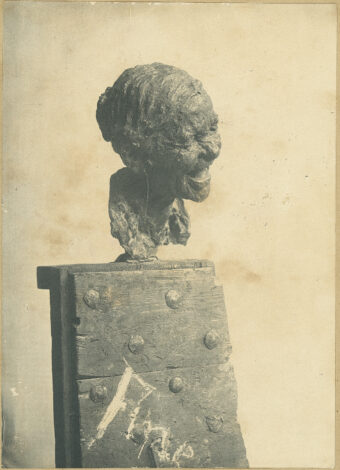
Rosso created the work in 1883, and it is documented in a photograph from that same year. He exhibited The End(with the woman’s head mounted in a slightly different position) at the 1887 Esposizione Artistica Nazionale of Venice and a photograph of the work was also reproduced in a periodical that year. While it is true that Boccioni’s inclusion of real objects in his sculptures might have been suggested at first by some of Rosso’s works, it is not clear if the Futurist artist actually saw The End. Moreover, and more significantly, The End, as opposed to Boccioni’s sculptures, relies on the surprise effect that derives from the choice of inserting an autonomous artistic object, the head, onto an extraneous, non-artistic one, the section from the wooden door. This work, therefore, depends more on a conceptual interplay, similar to the modern practice of installation, in which each and every object maintains its material coherence and its individual correlation with reality. It is the clash between the two autonomous elements, made of two different materials – the modeled head on one side, and the wooden section of a door on the other – that gives The End its startling, disorienting strength as an artistic object. The interaction between the two also suggests the re-contextualization of an object within a further narrative of meanings, similar to the process later developed by Constantin Brancusi in his endless creation, and substitution, of pedestals that reconfigure his pre-existing works. Boccioni, while writing extensively against the traditional codification of sculpture as an isolated object in itself, did not go so far as to experiment with the interaction between pedestal and statue in this way. The fact that the wooden door is cut and mounted diagonally, moreover, and the puzzling word, “fine” (the end), written in chalk on top of it, contribute to distancing it from a mere assembly of real objects. Indeed, as a contemporary critic has noted: “The door and the old woman stand in front of us like a riddle, which challenges us to use our brain.”29
Scholars have not identified the exact meaning of the title, “The End.” However, we know that Rosso constantly renamed this work with titles that refer to the role played by the old woman in the world of prostitution: La ruffiana, Mezzana, Maquerelle (all synonyms for “procuress”). Her obscene laugh reinforces the impression of moral degeneration, while her position on top of what looks like the section of a door makes her social status explicit. According to the inquest on the slums of Milan published by Paolo Valera in 1879, an old ex-prostitute, if she escaped the hospital for the syphilitics, would generally find, at the end of her career, a space as the doorkeeper of a brothel.30 Indeed, most of Rosso’s early works could be read as portraits from Valera’s Milanese subproletariat, including a triad (of sorts) of modern prostitution, composed by The End, along with the courtesan of Carne altrui (The Flesh of Others), and the pimp of El Locch (also known as The Smoker).31 Seen from this perspective, Rosso’s practice of installation becomes a means to expand, explain, and literally stage, three-dimensionally and photographically, the narrative and sociological background implied by the subject. The procuress opens the upper panel of the front door of the brothel and sticks her head out, with a brutal laugh. In a photograph from 1883, Rosso himself appears behind a panel, situated at the back of The End. From his image we can infer the height of the assembled work, in proportion to that of an adult human figure. When exhibited, the section of the door in Fine was tall enough to make sure that viewers would have been met face-to-face by the woman’s repulsive laugh.
Even in this early work, it is not the presence of real objects that matters as much as the perception of a glimpse of reality. The fragmentary nature of the wooden door, its role in “framing” the perception of the ensemble suggests a parallel to other contemporary works in which the selective gaze defines the subject not as an isolated entity, but as part of a visual flux. It is analogous to the case of Giacomo Balla’s Divisionist masterpieces Lavoro (Work, 1902) and Fallimento(Bankruptcy, 1903), where critics have identified the influence of photography in the unusual choice of the point of view.32
Photography was a major conceptual tool for Rosso, since the process of framing an image allowed him to fix a visual experience in time. Several documents tell us how closely he supervised the display of his works. In 1907, when he was invited to an exhibition in London, he accepted “on condition of being allowed to choose the works to show and to display them on his own, according the illumination that they needed in order to be shown at their best.”33 Besides taking photographs of his works himself, he was known to supervise any photographer tasked with reproducing them. Here, the flat surface of the door suggests a preferential way to look at the work: a full-frontal view. Interestingly, however, The End appeared in artistic journals as a drawing and as a photograph, from a viewpoint slightly shifted to the left. This revealed the nature of the wooden support, and the process of assemblage used by the sculptor. As Sharon Hecker has remarked: “In the installation photos, Rosso proposed a new relationship between sculpture and photography: he harnessed one inherently multiple medium to comment on another.”34
Compared to Rosso’s The End, Boccioni’s early assemblages, Fusion of a Head and a Window (1912-13, destroyed) (Figure 3), for example, are much more traditional in the relationship between the plaster human figure and the surrounding parts, but they also result from a more complex attitude toward the psychological role of matter and materials. This work employs a real window frame, with part of the windowpane cut diagonally and still present in the upper left side; the object gives the impression of fusing organically within the plaster mass of the human figure which, for its part, includes several other objects that refer individually to specific elements of reality. In this case, however, the correlation is not simply objective but metaphorical or at least mediated. Obviously, Boccioni could not use the “real thing” (a true anatomical specimen) in depicting a human figure and therefore resorts to providing a series of artificial substitutes: a glass eye, a wig, objects that are part of the commercial assortments of prosthetics created to integrate a real human body. It is significant, however, that, as opposed to Rosso, Boccioni did not refrain from inserting these objects within the plaster mass itself. Rosso’s plaster and wax surfaces are always defined by the visual and textural effects of one single material surface, at times enhanced by color, or by the emergence, from the sides, of the contrasting material features of the supporting medium: the uniformity of the surface is not disrupted by the insertion of foreign materials. This is due to a pivotal difference between Boccioni and Rosso. Boccioni, at this stage, was reconfiguring the principles of collage aesthetics and pushing boundaries with the materials he selected, working – one might even say playing – with our psychological associative faculties. Instead, Rosso often stated that his goal was to make the viewer “forget the material” of sculpture, which meant that he “drove materiality to such a low point that, in his sculpture” the material “could be seen through and not act like a material at all.”35 Rosso saw matter only as subsidiary to the event of perception, to the process of creating a “gaze.”
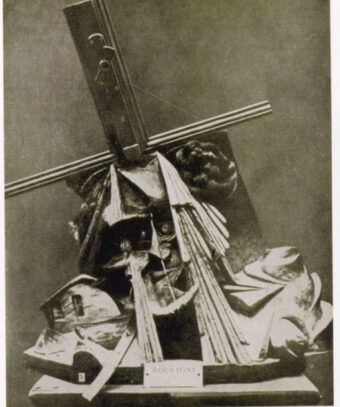
This is apparent if we analyze the different ways in which Rosso further addressed the problem of the interaction between subject and background, an issue that would become central to Boccioni. As Ardengo Soffici observed in 1909, “sometimes the author, instead of leaving his characters isolated in an environment that is not the one in which they appeared to him when he conceived them artistically, makes up for the lack of background with a plaster or bronze surface.”36 In 1883, Rosso created Se la fusse grappa! (in Milanese dialect: If only it were grappa!), also known as Lo scaccino (The Church Janitor) (Figure 4).37 A version of this work, dated by Lista to 1887, sports a plaster background surface in contrasting color, which surrounds the male bust. Rosso’s idea of the gaze, and the reconfiguration of the meaning of a sculpture within it, is exemplified by the more famous version of this work, which he exhibited in Venice in 1887, along with The End. The bust was shown together with a carefully selected group of props, explaining and expanding on the work’s humorous title. As a critic from the time explained: “There is a bust of an old drinker of distilled grapes, a firewater called grappa in Milanese dialect. Having gone to church, he looks at the stoup for the holy water and, instead of dipping his fingers in it, he exclaims: ‘If only it were grappa!”’38
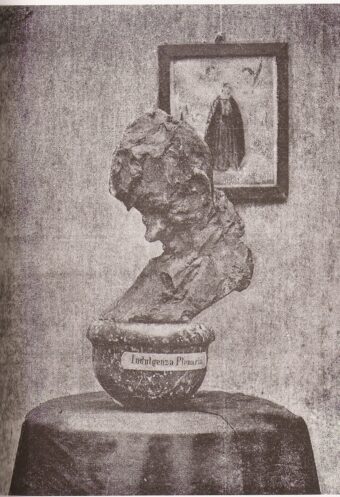
Rosso conceived this sort of installation to be observed from one preferential viewpoint. In a photograph of the work published at the time of the show in Venice, we see the man’s bust emerge from a real object, an acquasantiera – a basin for holy water. Rosso actually mounted what appears to be a plaster bust (the material he used for the work exhibited in Venice is not documented) on top of the granite bowl. Since the props used for the 1887 photograph have not survived, we are not sure if the artist took hold of an actual acquasantiera or of a granite bowl made to look like one.39 To make the object more recognizable, Rosso attached a paper label on it, which seems handwritten but made to look printed, promising “plenary indulgence” to anyone dipping his fingers into the holy water. Traditionally, this sort of inscription was positioned near the entryway of a church, outside or just above the stoup. The photograph also shows a votive painting in the background, which reaffirms the setting: the man is sitting in a church. We see his profile framed in a perspectival structure made of three distinct planes. In the forefront, the water basin, which we could imagine attached on the left side to a wall (the inscription, supposedly on the side on full view, is on the right); on a middle plane, we see the old man, his head reclined, maybe dozing off in an invisible pew; in the background, the holy image right behind the man. The insertion of this real-life object, the votive painting, on the wall in the background is essential for Rosso’s carefully staged construction of space, and of spatial illusion. It is this third, separate object that allows us to perceive the interaction of real and fictive planes and to suggest – fallaciously – that the image of the man and the image of the holy water basin reside on two different perspectival planes. Rosso carefully placed the sculpture so that it is only partially supported by the basin. The bust’s short, horizontal lower margin lies comfortably on the straight border of the granite basin, but the two do not interact any further, and the rest of the man’s bust floats halfway in the air on the right side, completely out of the basin. It is clear that Rosso carefully supervised the photographic illustration of the work exhibited in Venice to impose a specific point of view. In the photograph, the sculpture is inserted between two objects, suggesting a succession of planes –a solution mastered at the time by Mosè Bianchi in his genre paintings of church interiors. Bianchi’s paintings and prints, such as Fratelli al campo (Brothers in the field, 1869, Milan, Pinacoteca di Brera) and Nel Duomo di Monza (In the Duomo of Monza, 1872 circa, Monza, Musei Civici), often employ the same strategy: several profiles of women, facing the same direction but distributed on parallel planes, cut across the background, creating a perspectival progression (Figure 5).40
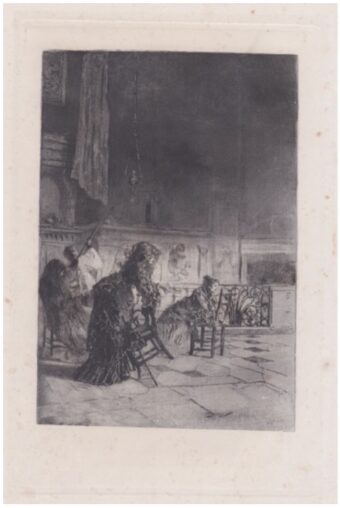
In his first works, Boccioni also struggled with the question of the gaze and how to transform the interaction between object and background from a two-dimensional to a three-dimensional construction. This is evident in some of his earliest sculptures, like the already cited Fusion of a Head and a Window, Antigrazioso (1912-13), and Head+House+Light (1912-13, destroyed) (Figure 6).
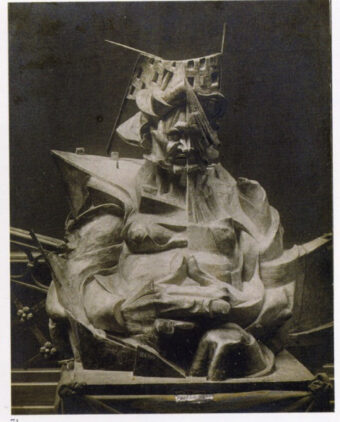
All of these works evolve from a series of drawings and paintings in which Boccioni had studied the visual interactions between figure and background as effects of superimposition, which led eventually, in his sculptures, to a veritable fusion.41 The first sculpture derives from the motif of a head seen against the light emanating from a window in the background, explored in the drawing Controluce (1910, private collection). Margherita Sarfatti saw in this drawing the beginning of Boccioni’s experiments for what he later theorized as interpenetrations of planes.42 The other two sculptures grow from Boccioni’s masterpiece Materia (1912-13, Mattioli collection) (Figure 7) and from several other paintings and drawings connected to it. They show the façade of a building, visible in the distance, projected onto (and in the sculptures actually attached to) the head of the artist’s mother. Head and house form a single mass, a continuum. Instead of “installing” his sculptures in a carefully-selected, three-dimensional environment, Boccioni tried here to solve the problem posited by his desire, expressed in the Manifesto of Futurist Sculpture, to fuse the object and its environment. In other words, while Rosso used installation and photography in his early sculptures to suggest a distancing of the visual planes in which the sculptural portrait is inserted, Boccioni was doing the opposite in his own first experiments with sculpture. Boccioni’s assemblages are the result of a veritable collapse of multiple visual planes onto one single mass, conceived as the conflation of what is faraway and what is nearby.
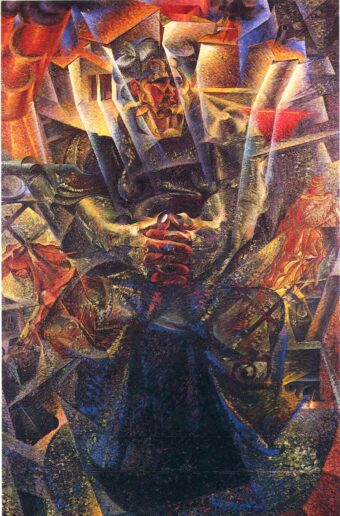
Boccioni started distancing himself from Rosso in the preface he wrote for the catalogue of his exhibition of sculptures in Paris. Resurrecting Baudelaire’s judgment, he declared: “I intend, in short, to make the figure live in its environment, without making it a slave of artificial or fixed lights, or of a physical support.”43 Eventually, the flaws that Boccioni also identified in Rosso’s sculptural conceptions led him to abandon his own multimaterial experiments. Let’s return to what he wrote in Futurist Painting Sculpture: “Rosso’s revolution […] relies upon an external pictorial concept and neglects the problem of a new construction of planes.”44 For Boccioni, Futurist sculpture must instead react against this fragmentary tendency, it must be conceived “not only as a construction of masses, but also in such a way that the sculptural mass will have in itself the architectonic elements of the sculptural environment in which the subject lives.”45
This implies a reconsideration of Rosso’s diktat against the plurality of viewpoints in sculpture as well as a reconsideration of the viewer’s engagement. And it is on this alternative path that Boccioni’s work will evolve, away from the single “gaze” or visual impression, as Rosso had wanted. Already in Fusion of a Head and a Window, we find a deviation from this route, metaphorical but also literal. If we look at the sculpture from a side, we can see that Boccioni inserted into it an element that calls for a conceptual alternative to the single viewpoint (Figure 8). He reconstructed the figure’s profile with one single, metal wire, thus exploiting the traditional procedure of constructing a plaster sculpture. The wire, chiseled in thin air, has no real structural function and is invisible from a frontal view. Its role is simply metaphorical; it suggests the idea of the head’s profile without evoking any realistic, visual impression of it.46
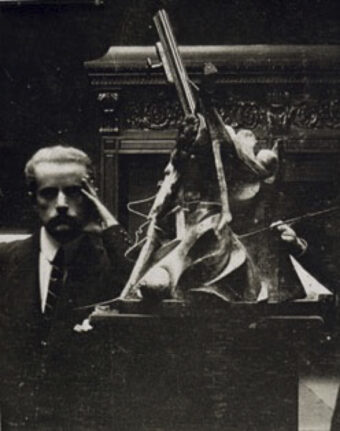
This simple wire marks an important shift in Boccioni’s attitude toward sculpture and vision, and toward Rosso’s opinions on both. His subsequent works, namely the extant Development of a Bottle in Space (1912-13) and Unique Forms of Continuity in Space (1913), reconsidered the function of exactly those “enclos[ing] stark, still, definite lines” that Rosso, in Soffici’s words, deprecated. In the preface for the catalogue of his 1913 sculpture exhibition, Boccioni wrote: “Traditional sculptors make the statue turn on itself in front of the spectator or make the spectator turn around the statue. […] My spiral architectural construction instead creates in front of the spectator a continuity of forms that allows him to follow […] a new closed line that determines the body in its material motions.”47
Moving away from Soffici’s and Rosso’s Impressionist viewpoint, Boccioni also did not embrace the Cubists’ dissolution of form into a conflation of multiple facets. Instead, he tried to reunite the mobility of the viewpoint with the principles of a dynamic construction, “showing the thickness of any given profile, and not just several immobile, silhouetted profiles.”48 For him, it is the spectator, and not just the sculptor that “must, ideally, construct a [visual] continuity.”49
We do not know what Rosso thought when he saw Boccioni’s sculptural achievements in 1913. But it is obvious that what the Futurist artist sought to achieve was not just based on a set of ideas which he had pillaged from Rosso’s atelier. His “modern way,” predicated on dynamism, ultimately sought a new visual synthesis, capable of moving away from a “unique point of view,” toward those “unique forms” that will characterize much of his later work.50
Bibliography
Anonymous, VI Esposizione nazionale artistica Venezia 1887. Quadri e statue. Treves Editori: Milan, 1887.
Bacci, Francesca. “Momentary vs. Monumentary: Medardo Rosso and Public Sculpture”, in Sculpture Journal, XXII, no. 1 (2013): 86.
Birolli, Zeno, ed. Umberto Boccioni. Gli scritti editi ed inediti, vol. 1. Milan: Feltrinelli, 1971.
Boccioni, Umberto. Futurist Painting Sculpture (Plastic Dynamism), edited by Maria Elena Versari, translated by Richard Shane Agin and Maria Elena Versari. Los Angeles: Getty Research Institute Publications, 2016.
Boccioni, Umberto. Lettere Futuriste, ed. by Federica Rovati. Milan: Skira 2009.
Brunk, Birgit. “Sculpture for the Seeing. The ‘punto di vista unico,’ a Lifelong Search for the Truth,” in Medardo Rosso, ed. by Dieter Schwarz. Düsseldorf: Richter Verlag, 2004.
Carli, Alberto. “A mezzanotte la stanchezza le vince tutte. Ritratti scapigliati e veristi di ruffiane e prostitute,” Giornale di storia, no. 34 (2020). online at https://www.giornaledistoria.net/saggi/a-mezzanotte-la-stanchezza-le-vince-tutte-ritratti-scapigliati-e-veristi-di-ruffiane-e-prostitute/.
Claris, Edmund. De L’Impressionisme en sculpture. Paris: Éditions de la «Nouvelle Revue», 1902.
Doane, Mary Ann. The Emergence of Cinematic Time: Modernity, Contingency, and the Archive. Boston: Harvard University Press, 2002.
Esposizione Nazionale Artistica Illustrata, 1887.
Ginex, Giovanna. Album del Divisionismo. Milan: Electa, 2021.
Ginex, Giovanna. “Boccioni e la fotografia”, in Boccioni Pittore Scultore Futurista, edited by Laura Mattioli Rossi, Milan: Skira, 2006, 137-155.
Hecker, Sharon. A Moment’s Monument. Medardo Rosso and the International Origins of Modern Sculpture. Berkeley: University of California Press, 2017.
Hecker, Sharon. “Fleeting Revelations. The Demise of Duration in Medardo Rosso’s Wax Sculpture,” in Ephemeral Bodies. Wax Sculpture and the Human Figure, edited by Roberta Panzanelli. Los Angeles: Getty Research Institute Publications, 2008.
Lista, Giovanni, and Paolo Baldacci, Livia Velani, eds. Balla. La modernità futurista. Milan: Skira, 2008.
Lista, Giovanni. Scultura e fotografia. Milan: 5 Continents Edizioni, 2003.
Mattioli Rossi, Laura, ed. Boccioni 1912 Materia. Milan: Mazzotta, 1991.
Mattioli Rossi, Laura, ed. Boccioni Pittore Scultore Futurista. Milan: Skira, 2006.
Mezzetti, Amalia. L’acquaforte lombarda nella seconda metà dell’800. Milan: Famiglia Meneghina, 1935.
Mola, Paola, and Fabio Vittucci. Medardo Rosso. Catalogo ragionato della scultura. Milan: Skira, 2009.
Rictus, Jean. Journal quotidien 1898-1933. XIXe-Xxe s. 1er juillet – 30 septembre 1912. September 28, 1912.
Rictus, Jean. Journal quotidien 1898-1933. XIXe-Xxe s. 1er juillet – 30 septembre 1912, September 30, 1912.
Rictus, Jean. Journal quotidien 1898-1933. XIXe-Xxe s. 1er octobre– 30 novembre 1912. October 1, 1912..
Rictus, Jean. “Un Précurseur: Medardo Rosso (Le Sculpteur de Lumière),” Comoedia, VII, no. 1920, January 3, 1913.
Sarfatti, Margherita. “L’opera di Umberto Boccioni,” Gli Avvenimenti, II, no. 39, September 24 1916.
Soffici, Ardengo. Il caso Medardo Rosso. Preceduto da L’impressionismo e la pittura italiana. Florence: Seeber, 1909.
Soriau, Paul. L’esthetique du mouvement. Paris : Alcan, 1889.
Valera, Paolo. Milano sconosciuta. Con una lettera all’autore dell’avvocato Francesco Giarelli, Milan: Bignami, 1879.
Versari, Maria Elena. “Impressionism Solidified: Umberto Boccioni’s Works in Plaster and the Definition of Modernity in Sculpture,” in Plaster Casts: Making, Collecting and Displaying from Classical Antiquity to the Present, ed. Rune Frederiksen and Eckart Marchand. Berlin: De Gruyter, 2010.
Versari, Maria Elena. “On the unicity of forms,” in Boccioni in Brazil. Reassessing Unique Forms of Continuity in Space and its Material, edited by Ana Magalhães and Rosalind McKever, São Paulo, EDUSP, 2022.
Versari, Maria Elena. “Recasting the Past: On the Posthumous Fortune of Futurist Sculpture,” Sculpture Journal, XXIII, no. 3 (2014): 349-368.
- For Rictus’s judgement on the manifesto, see Jehan Rictus, Journal quotidien 1898-1933. XIXe-Xxe s. 1er juillet – 30 septembre 1912, samedi 28 septembre 1912, p. 228; Bibliothèque Nationale de France, Archives et manuscrits-Gallica. See also Giovanni Lista, Scultura e fotografia, Milan, 5 Continents Edizioni, 2003, p. 335. For Rosso and Rictus’s planning of the article, see Jehan Rictus, Journal quotidien 1898-1933. XIXe-Xxe s. 1er octobre– 30 novembre 1912, mardi 1er octobre 1912, p. 1; Bibliothèque Nationale de France, Archives et manuscrits-Gallica. I would like to thank Vivien Greene and Sharon Hecker for organizing the CIMA panel at the College Art Association Conference devoted to Rosso in which I first presented the ideas contained in this article. Sharon and Vivien provided me with very important feedback on my talk. I would also like to thank Matteo Crespi and the Galleria Il Bulino Antiche Stampe in Milan for kindly allowing me to reproduce Mosé Bianchi’s print Interior of a Church in Milan (Figure 5).
- Jehan Rictus, Journal quotidien 1898-1933. XIXe-Xxe s. 1er juillet – 30 septembre 1912, lundi 30 septembre 1912, 235; Bibliothèque Nationale de France, Archives et manuscrits-Gallica.
- Jean Rictus, “Un Précurseur: Medardo Rosso (Le Sculpteur de Lumière),” in Comoedia, VII, n. 1920, 3 Janvier 1913, p. 1.
- The remark is by Zeno Birolli, in Umberto Boccioni, Gli scritti editi ed inediti, ed. by Zeno Birolli, Milan, Feltrinelli, 1971, p. 430.
- Ardengo Soffici, Il caso Medardo Rosso. Preceduto da L’impressionismo e la pittura italiana, Firenze, Seeber, 1909, p. 54.
- Umberto Boccioni, Lettere Futuriste, ed. by Federica Rovati, Milan, Skira 2009, p. 18.
- Soffici, Il caso Medardo Rosso…, cit., p. 56.
- Rosso’s statement in Edmund Claris, De L’Impressionisme en sculpture, Paris, Éditions de la “Nouvelle Revue”, 1902, p. 55. Italian translation in Soffici, Il caso Medardo Rosso…, cit., p. 96. Rosso’s text is published in its entirety in Italian translation in Soffici’s book (pp. 93-96).
- Rosso’s statement in Claris, De l’Impressionisme en sculpture, cit., p. 55. Cfr. the Italian translation in Soffici, Il caso Medardo Rosso, cit., p. 96.
- Rosso’s quoting here, imprecisely, the famous passage by Paul Soriau (L’esthetique du mouvement, Paris, Alcan, 1889, p. 245) later used by the Futurists in their Technical Manifesto of Futurist Painting (1910): “For the watching eye, the flying bird does not have two wings, it has at least four; the trotting horse does not have four legs, it has at least eight.” See Mary Ann Doane, The Emergence of Cinematic Time: Modernity, Contingency, and the Archive, Boston, Harvard University Press, 2002, p. 83.
- Baudelaire cited in Claris, De l’Impressionisme en sculpture, cit., p. 27.
- Soffici, Il caso Medardo Rosso, cit., p. 56.
- Ibidem, p. 57.
- Ibidem, p. 58.
- Umberto Boccioni, “Preface to the Catalogue of the First Exhibition of Futurist Sculpture,” in Id., Futurist Painting Sculpture (Plastic Dynamism), ed. by Maria Elena Versari, transl. by Richard Shane Agin and Maria Elena Versari, Los Angeles, Getty Research Institute Publications, 2016, p. 180.
- Rosso’s statement in Claris, De l’Impressionisme en sculpture, p. 52. Cfr. the Italian translation in Soffici, Il caso Medardo Rosso…, cit., p. 56 and 95.
- Rosso’s statement in Claris, De l’Impressionisme en sculpture, cit, p. 32 and cit. in Soffici, p. 95.
- Umberto Boccioni, Diary entry dated April 1, 1908, in Gli scritti editi ed inediti, ed. by Zeno Birolli, vol. 1, Milan, Feltrinelli, p. 299.
- Boccioni, Carrà, Russolo, Balla, Severini, “Technical Manifesto of Futurist Painting” (1910), in Boccioni, Futurist Painting Sculpture…, cit., p. 169.
- See Maria Elena Versari, “Introduction,” in Boccioni, Futurist Painting Sculpture, cit., p. 33.
- Vittore Grubicy, Il disegno, Milan 1911, quoted in Giovanna Ginex, Album del Divisionismo, Milan: Electa, 2021, p. 33.
- Boccioni, Futurist Painting Sculpture…, cit., p. 125.
- Boccioni, Futurist Painting Sculpture…, cit., p. 90.
- Ibidem, pp. 180-181.
- Ibidem, p. 181.
- Lista, Medardo Rosso…, cit., p. 13.
- Paola Mola an Fabio Vittucci, Medardo Rosso. Catalogo ragionato della scultura, Milan, Skira, 2009, pp. 66-70; 237-238. Several scholars refer to the head in Fine as a bronze. There is however no definitive consensus, and it might have been a painted plaster.
- Birgit Brunk, “Sculpture for the Seeing. The ‘punto di vista unico,’ a Lifelong Search forthe Truth,” in Medardo Rosso, ed. by Dieter Schwarz, Düsseldorf, Richter Verlag, 2004, p. 16.
- Quoted in Mola and Vittucci, Medardo Rosso…, cit., p. 238.
- Paolo Valera, Milano sconosciuta. Con una lettera all’autore dell’avvocato Francesco Giarelli, Milan, Bignami 1879, p. 104 and (“a disfigured and big-mouthed old crone sitting in front of the house # 3 invites us with her eye”) p. 123. See also Alberto Carli, “A mezzanotte la stanchezza le vince tutte. Ritratti scapigliati e veristi di ruffiane e prostitute,” in Giornale di storia, n. 34, 2020, online at https://www.giornaledistoria.net/saggi/a-mezzanotte-la-stanchezza-le-vince-tutte-ritratti-scapigliati-e-veristi-di-ruffiane-e-prostitute/.
- The Milanese term “locch” literally meaning “fool, hooligan” indicated a petty criminal that lives off shady dealings, including the prostitution of his lover. See for instance Valera, Milano sconosciuta…, cit., p. 9: “You see the trollop deeply in love with the locch, and him loving her back.”
- Lista, “Divisionismo e visione fotografica,” in Balla. La modernità futurista, ed. by Giovanni Lista, Paolo Baldacci, Livia Velani, Milan, Skira 2008, p. 22.
- Lista, Medardo Rosso…, cit., p. 393.
- Sharon Hecker, A Moment’s Monument. Medardo Rosso and the International Origins of Modern Sculpture, Berkeley, University of California Press, 2017, p. 207.
- Sharon Hecker, “Fleeting Revelations. The Demise of Duration in Medardo Rosso’s Wax Sculpture,” in Ephemeral Bodies. Wax Sculpture and the Human Figure, ed. by Roberta Panzanelli, Los Angeles, Getty Research Institute Publications, 2008, p. 140.
- Soffici, Il caso Medardo Rosso…, cit., p. 58.
- Mola and Vittucci, Medardo Rosso. Catalogo ragionato…, cit., pp. 74; 238-242.
- Anonymous, VI Esposizione nazionale artistica Venezia 1887. Quadri e statue, Treves Editori, Milan 1887, p. 35; cit. in Giovanni Lista, Medardo Rosso…, cit., p. 73. The critic does not cite the presence of the votive image in the background, which is however visible in the photograph used to illustrate the work in the publication devoted to the Venice show, the Esposizione Nazionale Artistica Illustrata of 1887.
- See Mola and Vittucci, Medardo Rosso. Catalogo ragionato…, cit., p. 34.
- Bianchi’s print Interno di una chiesa a Milano reproduces his famous painting Nel Duomo di Monza (1872) exhibited at Brera in 1874 and purchased by the King of Belgium. The print was issued in Paris with the title Intérieur d’Eglise à Milan. See Amalia Mezzetti, L’acquaforte lombarda nella seconda metà dell’800, Milan, Famiglia Meneghina, 1935, pp. 78-80, n.88.
- For this issue see in particular the analysis of Laura Mattioli Rossi, in the catalogues Boccioni 1912 Materia, ed. by Laura Mattioli Rossi, Milan, Mazzotta 1991 and Boccioni Pittore Scultore Futurista, ed. by Laura Mattioli Rossi, Milan, 2006 (in particular Mattioli Rossi’s essay, “Dalla scultura d’ambiente alle forme uniche della continuità nello spazio”, pp. 16-81). See also my “Impressionism Solidified: Umberto Boccioni’s Works in Plaster and the Definition of Modernity in Sculpture,” in Plaster Casts: Making, Collecting and Displaying from Classical Antiquity to the Present, ed. Rune Frederiksen and Eckart Marchand, Berlin, De Gruyter, 2010, pp. 331-350.
- Margherita Sarfatti, “L’opera di Umberto Boccioni,” in Gli Avvenimenti, II, n. 39, 24 September 1916, pp. 12-15.
- Boccioni, “Preface to the Catalogue of the First Exhibition of Futurist Sculpture,” in Id., Futurist Painting Sculpture, cit., p. 186. For the repercussion of this judgement on Boccioni’s posthumous casts, see Versari, “Recasting the Past: On the Posthumous Fortune of Futurist Sculpture,”Sculpture Journal, XXIII, Issue 3, 2014, pp. 349-368. On the issue of natural versus fixed light in Rosso, see Francesca Bacci, “Momentary vs. monumentary: Medardo Rosso and public sculpture”, in Sculpture Journal, XXII, Issue 1, 2013, p. 86.
- Boccioni, “Technical Manifesto of Futurist Sculpture” (1912), in Id., Futurist Painting Sculpture, cit. p. 181.
- Boccioni, “Technical Manifesto of Futurist Sculpture” (1912), in Id., Futurist Painting Sculpture, cit. Ibidem, p. 181.
- See Giovanna Ginex, “Boccioni e la fotografia”, in Boccioni Pittore Scultore Futurista, ed. by Laura Mattioli Rossi, cit., p. 137-165 and Maria Elena Versari, “Impressionism Solidified…”, cit.., p. 342.
- Boccioni, “Preface to the catalogue of the First Exhibition of Futurist Sculpture” (1913), in Id., Futurist Painting Sculpture, cit. p. 186.
- Ibidem, p. 186.
- Ibidem, p. 186.
- See Maria Elena Versari, “On the unicity of forms,” in Boccioni in Brazil. Reassessing Unique Forms of Continuity in Space and its Material, ed. by Ana Magalhães and Rosalind McKever, São Paulo, EDUSP, 2022, p. 104-145.

